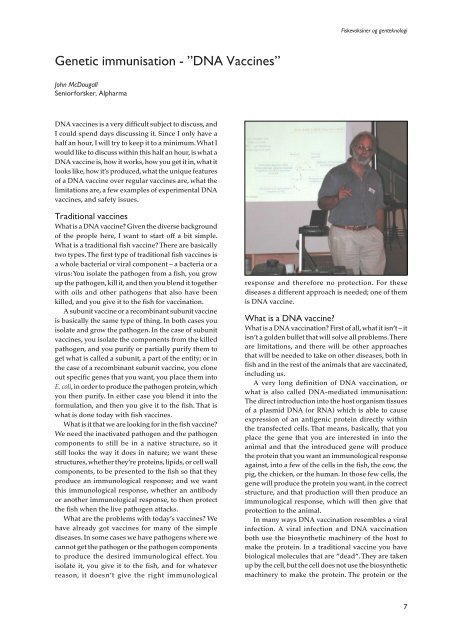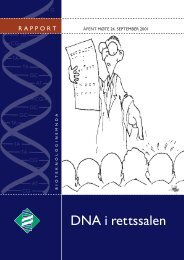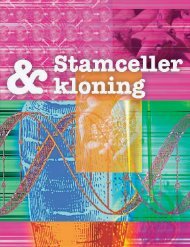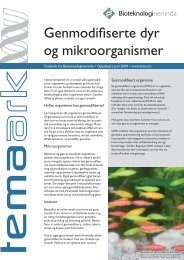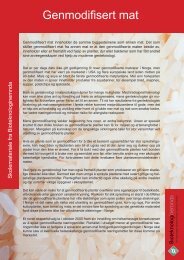Fiskevaksiner og genteknologi â Internseminar - Bioteknologinemnda
Fiskevaksiner og genteknologi â Internseminar - Bioteknologinemnda
Fiskevaksiner og genteknologi â Internseminar - Bioteknologinemnda
- No tags were found...
You also want an ePaper? Increase the reach of your titles
YUMPU automatically turns print PDFs into web optimized ePapers that Google loves.
<strong>Fiskevaksiner</strong> <strong>og</strong> genteknol<strong>og</strong>iGenetic immunisation - ”DNA Vaccines”John McDougallSeniorforsker, AlpharmaDNA vaccines is a very difficult subject to discuss, andI could spend days discussing it. Since I only have ahalf an hour, I will try to keep it to a minimum. What Iwould like to discuss within this half an hour, is what aDNA vaccine is, how it works, how you get it in, what itlooks like, how it’s produced, what the unique featuresof a DNA vaccine over regular vaccines are, what thelimitations are, a few examples of experimental DNAvaccines, and safety issues.Traditional vaccinesWhat is a DNA vaccine? Given the diverse backgroundof the people here, I want to start off a bit simple.What is a traditional fish vaccine? There are basicallytwo types. The first type of traditional fish vaccines isa whole bacterial or viral component – a bacteria or avirus: You isolate the path<strong>og</strong>en from a fish, you growup the path<strong>og</strong>en, kill it, and then you blend it t<strong>og</strong>etherwith oils and other path<strong>og</strong>ens that also have beenkilled, and you give it to the fish for vaccination.A subunit vaccine or a recombinant subunit vaccineis basically the same type of thing. In both cases youisolate and grow the path<strong>og</strong>en. In the case of subunitvaccines, you isolate the components from the killedpath<strong>og</strong>en, and you purify or partially purify them t<strong>og</strong>et what is called a subunit, a part of the entity; or inthe case of a recombinant subunit vaccine, you cloneout specific genes that you want, you place them intoE. coli, in order to produce the path<strong>og</strong>en protein, whichyou then purify. In either case you blend it into theformulation, and then you give it to the fish. That iswhat is done today with fish vaccines.What is it that we are looking for in the fish vaccine?We need the inactivated path<strong>og</strong>en and the path<strong>og</strong>encomponents to still be in a native structure, so itstill looks the way it does in nature; we want thesestructures, whether they’re proteins, lipids, or cell wallcomponents, to be presented to the fish so that theyproduce an immunol<strong>og</strong>ical response; and we wantthis immunol<strong>og</strong>ical response, whether an antibodyor another immunol<strong>og</strong>ical response, to then protectthe fish when the live path<strong>og</strong>en attacks.What are the problems with today’s vaccines? Wehave already got vaccines for many of the simplediseases. In some cases we have path<strong>og</strong>ens where wecannot get the path<strong>og</strong>en or the path<strong>og</strong>en componentsto produce the desired immunol<strong>og</strong>ical effect. Youisolate it, you give it to the fish, and for whateverreason, it doesn’t give the right immunol<strong>og</strong>icalresponse and therefore no protection. For thesediseases a different approach is needed; one of themis DNA vaccine.What is a DNA vaccine?What is a DNA vaccination? First of all, what it isn’t – itisn’t a golden bullet that will solve all problems. Thereare limitations, and there will be other approachesthat will be needed to take on other diseases, both infish and in the rest of the animals that are vaccinated,including us.A very long definition of DNA vaccination, orwhat is also called DNA-mediated immunisation:The direct introduction into the host organism tissuesof a plasmid DNA (or RNA) which is able to causeexpression of an antigenic protein directly withinthe transfected cells. That means, basically, that youplace the gene that you are interested in into theanimal and that the introduced gene will producethe protein that you want an immunol<strong>og</strong>ical responseagainst, into a few of the cells in the fish, the cow, thepig, the chicken, or the human. In those few cells, thegene will produce the protein you want, in the correctstructure, and that production will then produce animmunol<strong>og</strong>ical response, which will then give thatprotection to the animal.In many ways DNA vaccination resembles a viralinfection. A viral infection and DNA vaccinationboth use the biosynthetic machinery of the host tomake the protein. In a traditional vaccine you havebiol<strong>og</strong>ical molecules that are ”dead”. They are takenup by the cell, but the cell does not use the biosyntheticmachinery to make the protein. The protein or the7


